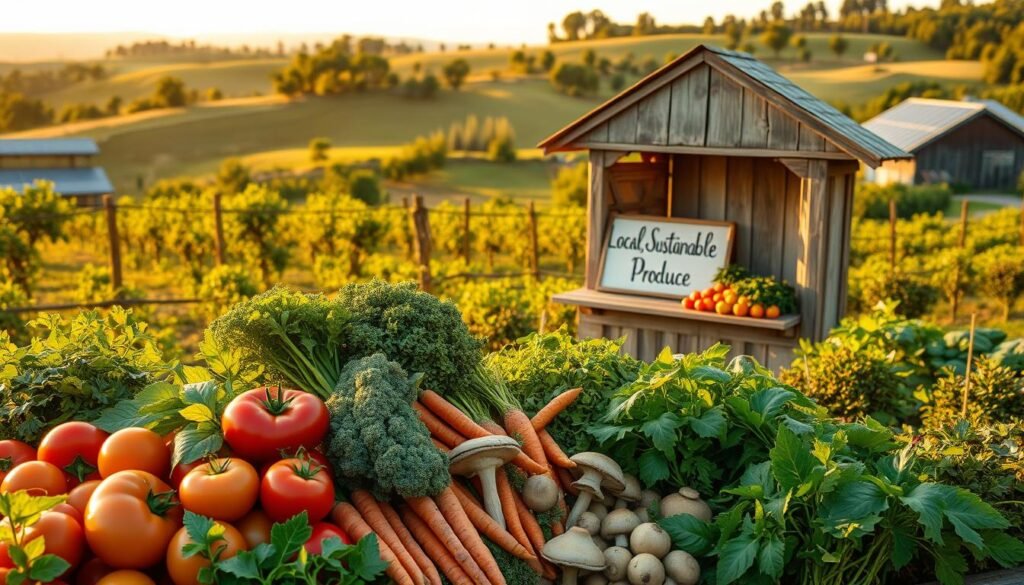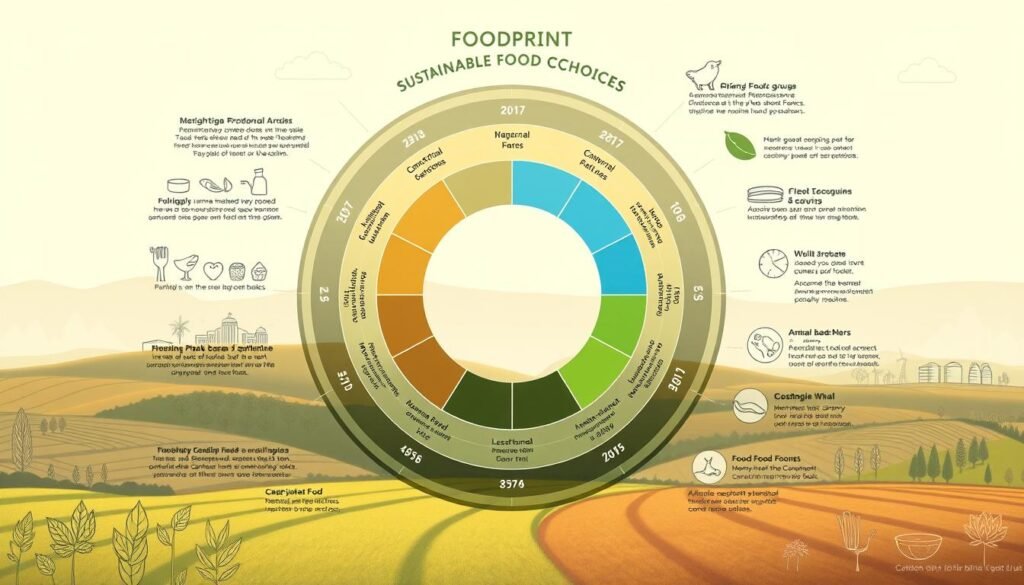Eating sustainably is more than just a trend; it’s a choice that benefits both our health and the planet. Sustainable food refers to a diet that is vibrant, delicious, and good for the environment.
By focusing on local, seasonal, and plant-based ingredients, we can make a significant impact on reducing our ecological footprint. This approach to eating supports sustainable farming practices and uses fewer resources, contributing to a healthier planet.
Making better choices every day can have a profound effect on the environment and our personal well-being. In this article, we’ll explore the importance of eco eating and provide practical tips on incorporating sustainable practices into your daily life.
Key Takeaways
- Eating sustainably benefits both health and the environment.
- Focus on local, seasonal, and plant-based ingredients.
- Support sustainable farming practices.
- Reduce ecological footprint through eco eating.
- Make a positive impact with daily choices.
What Is Sustainable Food?
Understanding sustainable food is crucial for making informed choices about what we eat. Sustainable food refers to the production and consumption of food in a way that minimizes its impact on the environment, supports local economies, and promotes social equity.

The Three Pillars of Food Sustainability
Food sustainability is based on three core pillars: environmental sustainability, social sustainability, and economic sustainability. Environmental sustainability involves farming practices that maintain soil health, conserve water, and protect biodiversity. Social sustainability ensures fair labor practices and supports local communities. Economic sustainability means that farming and food production are viable and profitable in the long term.
How Sustainable Food Differs from Conventional Food
Sustainable food differs significantly from conventional food in its production methods. While conventional farming often relies on chemical pesticides, synthetic fertilizers, and intensive monoculture farming, sustainable food production prioritizes organic and local food practices. This includes organic farming, agroforestry, and regenerative agriculture, which enhance soil health, biodiversity, and ecosystem services. By choosing sustainable food, consumers can support a more equitable and environmentally friendly food system.
The Environmental Impact of Our Food Choices
Eating sustainably is not just a trend; it’s a necessity given the environmental impact of our food choices. The food we eat affects the planet in numerous ways, from the resources required to produce it to the emissions generated during its transportation.
Carbon Footprint of Different Food Types
The carbon footprint of various foods varies significantly. Animal products, particularly beef and lamb, tend to have a larger carbon footprint compared to plant-based foods like vegetables and legumes. For instance, it’s estimated that beef production is responsible for around 19% of global greenhouse gas emissions. In contrast, plant-based diets can reduce an individual’s carbon footprint by up to 50%.

Water Usage and Land Degradation
Water usage is another critical factor in the environmental impact of food. Agriculture accounts for approximately 70% of global freshwater withdrawals, with certain crops like almonds and avocados requiring substantial water resources. Land degradation, often resulting from intensive farming practices, contributes to deforestation and biodiversity loss. Sustainable farming practices, such as crop rotation and organic farming, can help mitigate these issues.
Food Miles and Transportation Impact
The distance food travels from farm to table, known as food miles, also plays a role in its environmental impact. Transporting food contributes to greenhouse gas emissions, with air freight being particularly emissions-intensive. Choosing locally sourced produce can significantly reduce these emissions. For example, a study found that buying locally grown produce can cut transportation-related emissions by up to 90%.
| Food Type | Carbon Footprint (kg CO2e per kg) | Water Usage (liters per kg) |
|---|---|---|
| Beef | 27.3 | 15,000 |
| Chicken | 4.3 | 4,300 |
| Lentils | 0.9 | 4,000 |
By making informed choices about the food we eat, we can significantly reduce our environmental footprint. Embracing a diet rich in sustainable, locally sourced foods not only benefits our health but also contributes to a more eco-friendly food system.
Health Benefits of Sustainable Food Choices
Embracing sustainable food choices can lead to numerous health benefits, from improved nutrition to reduced chemical intake. Sustainable foods, often richer in essential nutrients and lower in harmful chemicals, provide a healthier alternative to conventional food options.
Nutritional Advantages of Sustainable Foods
Sustainable foods are typically produced using farming practices that enhance soil health, biodiversity, and efficient water use. These practices result in produce that is not only more nutritious but also has a better taste. For instance, organic farming methods avoid the use of synthetic fertilizers and pesticides, leading to food that is less contaminated and more beneficial for consumption.
Nutritionally dense foods like fruits, vegetables, and whole grains are more abundant in sustainable food systems. These foods provide essential vitamins, minerals, and antioxidants that are crucial for maintaining good health and preventing chronic diseases.
Reduced Exposure to Harmful Chemicals
Conventional farming often involves the use of chemical pesticides, herbicides, and fertilizers, which can leave residues on food. By choosing sustainable and organic food options, consumers can significantly reduce their exposure to these harmful chemicals. This reduction is particularly important for vulnerable populations such as children, pregnant women, and people with compromised immune systems.
The eco-friendly approach to farming not only benefits the environment but also contributes to a reduction in the intake of toxic substances through food. This aspect of sustainable eating is a crucial step towards a healthier lifestyle and a cleaner environment.
Understanding Food Labels and Certifications in Australia
Australian consumers are increasingly faced with a multitude of food labels, making it essential to comprehend the standards behind each certification to support sustainable eating. With various labels claiming to represent different aspects of sustainability, understanding these certifications is crucial.
Australian Certified Organic Standards
The Australian Certified Organic (ACO) standard is a prominent certification that ensures organic products meet strict guidelines. Products bearing the ACO label have been rigorously checked to comply with organic farming practices, free from synthetic pesticides, and genetically modified organisms (GMOs). This certification not only assures consumers of the product’s organic integrity but also supports eco-friendly farming practices.
Other Eco-Labels in the Australian Market
Beyond organic certifications, other eco-labels such as Fair Trade and Certified Humane play significant roles in promoting ethical consumerism. Fair Trade certification ensures that producers receive fair prices and adhere to social and environmental standards. Certified Humane labeling guarantees that farm animals are raised with respect for their welfare, in clean conditions, and on a diet free from antibiotics and hormones. These labels collectively contribute to a more sustainable food system.
For a comparative view, let’s examine some of these certifications side by side:
| Certification | Focus | Key Benefits |
|---|---|---|
| Australian Certified Organic | Organic farming practices | No synthetic pesticides, GMOs |
| Fair Trade | Fair labor practices | Fair prices, social and environmental standards |
| Certified Humane | Animal welfare | Clean conditions, no antibiotics or hormones |
Navigating Misleading Claims and Greenwashing
As consumers become more environmentally conscious, some businesses resort to greenwashing—making false or misleading claims about the environmental benefits of their products. To avoid falling prey to such practices, it’s crucial to look for reputable certifications and be aware of the standards they represent. For more insights on navigating food labels, visit this comparative study on food labels across 17.
By being informed about the various food certifications and labels, Australians can make more conscious choices that support sustainable food and eco eating practices.
Eating Local: Supporting Australian Farmers
Eating locally sourced food is a simple yet effective way to support Australian farmers and promote sustainability. By making conscious food choices, consumers can directly impact the local economy and environment.
Benefits of Buying from Local Producers
Buying from local producers has several benefits. It supports the local economy by keeping money within the community, promotes fresher and more nutritious food, and helps preserve the agricultural heritage of the region. Some key advantages include:
- Freshness: Local food is often picked at the peak of freshness, ensuring better taste and nutritional value.
- Economic Support: Directly supports local farmers and contributes to the local economy.
- Environmental Benefits: Reduces carbon footprint associated with long-distance food transportation.
Finding Farmers’ Markets Across Australian States
Farmers’ markets are an excellent way to access fresh, local produce while supporting Australian farmers. These markets are available across various states, offering a diverse range of products. To find a farmers’ market near you, check online directories or local community boards.
Community Supported Agriculture in Australia
Community Supported Agriculture (CSA) programs allow consumers to purchase a share of a farm’s produce on a regular basis. This model supports local farmers by providing them with a stable income and allows consumers to enjoy fresh, seasonal produce. Many Australian farms offer CSA programs, promoting a direct connection between consumers and producers.
By embracing local food options, Australians can contribute to a more sustainable food system, support local economies, and enjoy fresher, more nutritious food.
Seasonal Eating: A Guide for Australians
Embracing seasonal eating is a simple yet effective way to make a positive impact on the environment while enjoying fresher, more nutritious food. By choosing produce that is in season, Australians can reduce the carbon footprint associated with transportation, supporting local farmers and promoting eco eating practices.
Research has shown that seasonal patterns significantly influence food consumption. A study found that daily total food consumption was higher in winter than in summer, with a higher average intake of energy and nutrients observed during winter months. This shift in consumption patterns highlights the potential benefits of adapting our diets to the changing seasons, incorporating more organic and local food options.
To incorporate seasonal eating into daily life, Australians can visit local farmers’ markets, join community-supported agriculture programs, or plan meals around seasonal produce. For more information on seasonal eating patterns and their impact on food consumption, refer to research studies such as the one published on Oxford University’s Research Archive.
By making informed choices about the food we eat, we can contribute to a more sustainable food system that benefits both our health and the environment. Seasonal eating encourages a diverse and balanced diet, rich in a variety of fruits, vegetables, and other nutrient-dense foods, aligning with the principles of eco eating and promoting a healthier lifestyle.





